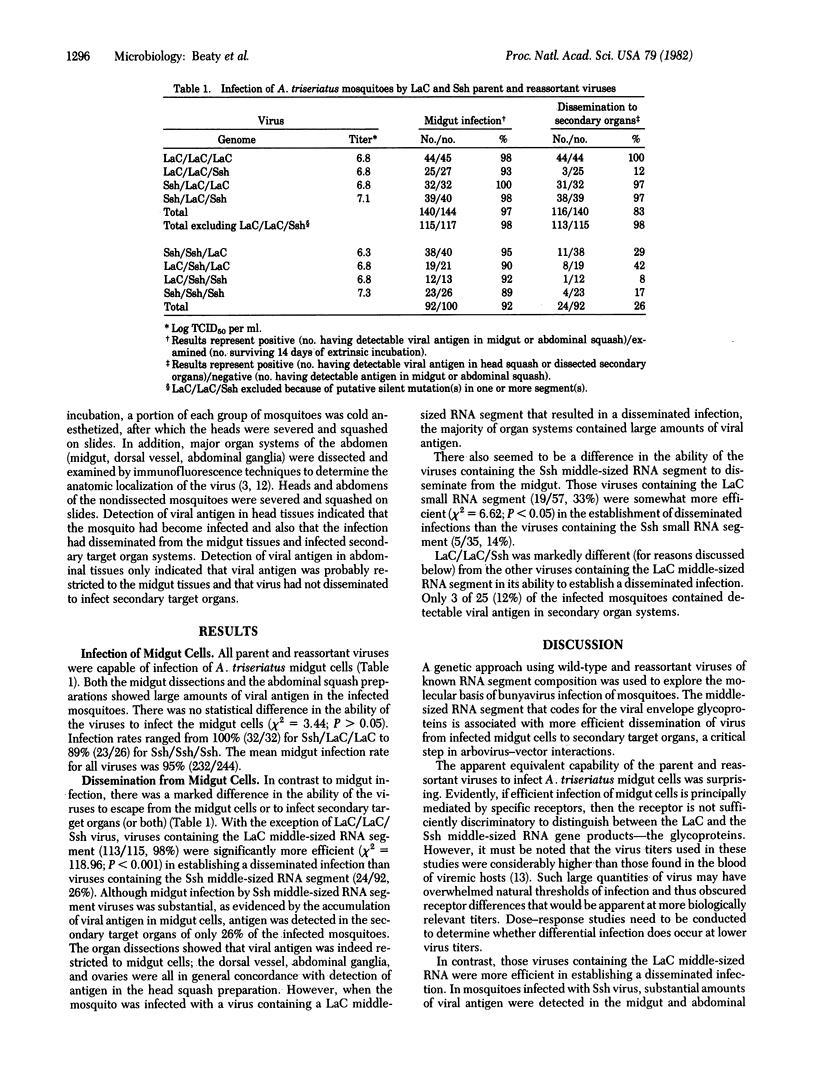Abstract
The molecular basis of bunyavirus per os infection of mosquitoes was determined; La Crosse (LaC), snowshoe hare (Ssh), and LaC-Ssh reassortment viruses were compared for their ability to infect Aedes triseriatus, the natural vector of the LaC virus. The viruses were comparable in their ability to infect midgut cells; 115 of 117 (98%) mosquitoes ingesting viruses containing the LaC middle-sized RNa segment and 92/100 (92%) of mosquitoes ingesting viruses containing the Ssh middle-sized RNA segment became infected. However, those viruses containing the LaC middle-sized RNA segments disseminated efficiently (113/115, 98%) from the midgut to infect secondary target organs. Those viruses containing the Ssh middle-sized RNA segment efficiently infected the midgut and large amounts of viral antigen were detected in the midgut cells but antigen was detected in the secondary target organs only in 26% (24/92) of the mosquitoes with midgut infection. Thus, the middle-sized RNA segment seems to be the major determinant for successful dissemination of LaC virus from infected A. triseriatus midgut cells.
Full text
PDF


Selected References
These references are in PubMed. This may not be the complete list of references from this article.
- Beaty B. J., Holterman M., Tabachnick W., Shope R. E., Rozhon E. J., Bishop D. H. Molecular basis of bunyavirus transmission by mosquitoes: role of the middle-sized RNA segment. Science. 1981 Mar 27;211(4489):1433–1435. doi: 10.1126/science.6781068. [DOI] [PubMed] [Google Scholar]
- Beaty B. J., Rozhon E. J., Gensemer P., Bishop D. H. Formation of reassortant bunyaviruses in dually infected mosquitoes. Virology. 1981 Jun;111(2):662–665. doi: 10.1016/0042-6822(81)90367-6. [DOI] [PubMed] [Google Scholar]
- Beaty B. J., Thompson W. H. Delineation of La Crosse virus in developmental stages of transovarially infected Aedes triseriatus. Am J Trop Med Hyg. 1976 May;25(3):505–512. doi: 10.4269/ajtmh.1976.25.505. [DOI] [PubMed] [Google Scholar]
- Beaty B. J., Thompson W. H. Tropisms of La Crosse virus in Aedes triseriatus (Diptera: Culicidae) following infective blood meals. J Med Entomol. 1978 Feb 10;14(5):499–503. doi: 10.1093/jmedent/14.5.499. [DOI] [PubMed] [Google Scholar]
- CHAMBERLAIN R. W., SUDIA W. D. Mechanism of transmission of viruses by mosquitoes. Annu Rev Entomol. 1961;6:371–390. doi: 10.1146/annurev.en.06.010161.002103. [DOI] [PubMed] [Google Scholar]
- LeDuc J. W. The ecology of California group viruses. J Med Entomol. 1979 Sep 12;16(1):1–17. doi: 10.1093/jmedent/16.1.1. [DOI] [PubMed] [Google Scholar]
- McLintock J. Mosquito-virus relationships of American encephalitides. Annu Rev Entomol. 1978;23:17–37. doi: 10.1146/annurev.en.23.010178.000313. [DOI] [PubMed] [Google Scholar]
- Pantuwatana S., Thompson W. H., Watts D. M., Hanson R. P. Experimental infection of chipmunks and squirrels with La Crosse and Trivittatus viruses and biological transmission of La Crosse virus by Aedes triseriatus. Am J Trop Med Hyg. 1972 Jul;21(4):476–481. doi: 10.4269/ajtmh.1972.21.476. [DOI] [PubMed] [Google Scholar]
- Rozhon E. J., Gensemer P., Shope R. E., Bishop D. H. Attenuation of virulence of a bunyavirus involving an L RNA defect and isolation of LAC/SSH/LAC and LAC/SSH/SSH reassortants. Virology. 1981 May;111(1):125–138. doi: 10.1016/0042-6822(81)90659-0. [DOI] [PubMed] [Google Scholar]
- Rubin D. H., Fields B. N. Molecular basis of reovirus virulence. Role of the M2 gene. J Exp Med. 1980 Oct 1;152(4):853–868. doi: 10.1084/jem.152.4.853. [DOI] [PMC free article] [PubMed] [Google Scholar]
- Shope R. E. Arbovirus-related encephalitis. Yale J Biol Med. 1980 Jan-Feb;53(1):93–99. [PMC free article] [PubMed] [Google Scholar]
- Weiner H. L., Drayna D., Averill D. R., Jr, Fields B. N. Molecular basis of reovirus virulence: role of the S1 gene. Proc Natl Acad Sci U S A. 1977 Dec;74(12):5744–5748. doi: 10.1073/pnas.74.12.5744. [DOI] [PMC free article] [PubMed] [Google Scholar]
- Weiner H. L., Powers M. L., Fields B. N. Absolute linkage of virulence and central nervous system cell tropism of reoviruses to viral hemagglutinin. J Infect Dis. 1980 May;141(5):609–616. doi: 10.1093/infdis/141.5.609. [DOI] [PubMed] [Google Scholar]


